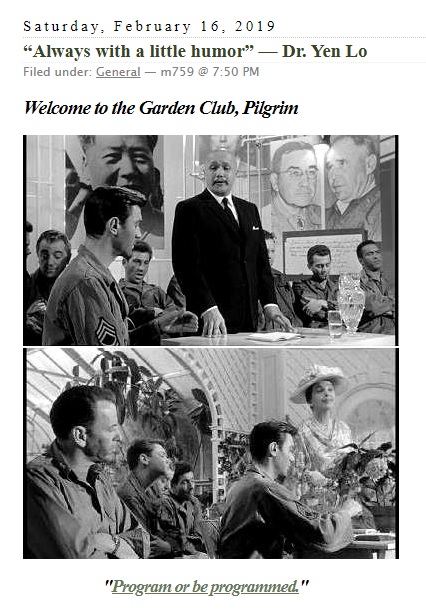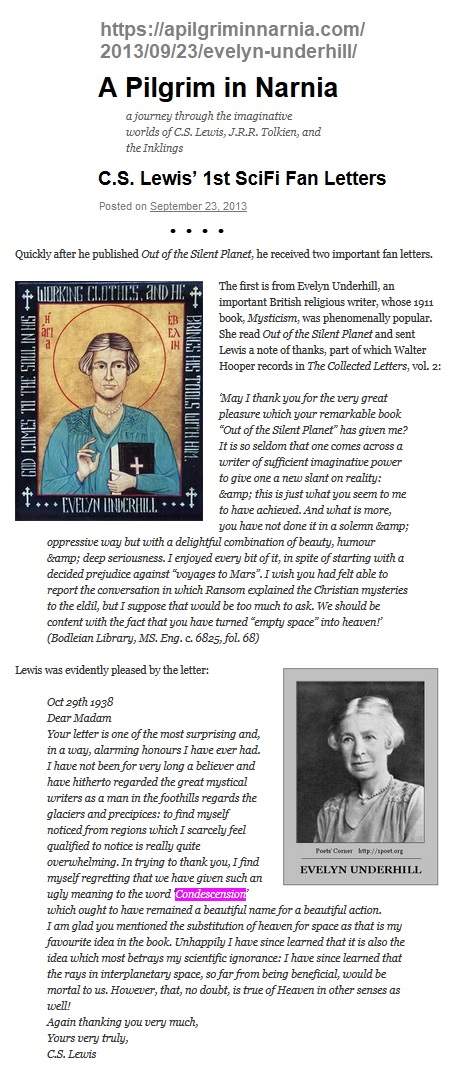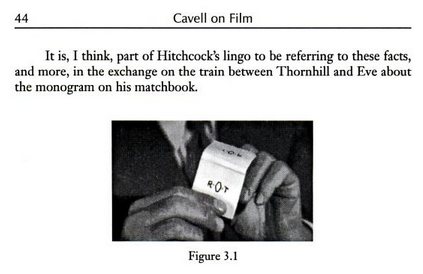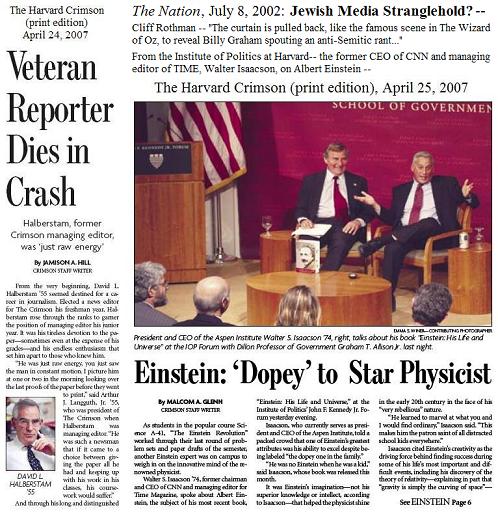See also earlier Pilgrim posts.
Wednesday, June 28, 2023
Thursday, June 8, 2023
Thursday, December 3, 2020
Pilgrim’s Progress
Monday, July 15, 2019
Thursday, January 8, 2015
Pilgrims
"Pilgrims to James Joyce's grave in Zurich, Switzerland,
continue to have their reveries fed by Hebald's 1966
life size bronze capturing the great modernist author
deep in thought, with open book in hand."
— LA Times obituary for Milton Hebald, sculptor,
who reportedly died at 97 on Twelfth Night
(Monday, January 5, 2014)
Related material: Joyce + Zurich + Serpent
in this journal.
Sunday, August 18, 2024
Heart of Weir’d . . . For Mr. Kurtz
|
A brief excerpt from a 2018 book about the woman who inspired Zen and the Art of Motorcycle Maintenance . . . "There is a passage in Joseph Conrad’s novella, Heart of Darkness (1899), which exemplifies much about what Quality means . . . . … the narrator, Marlow … is … in an environment he finds malign, sinister, macabre, chaotic, indifferently cruel, and nightmarishly meaningless. What saves him is his accidental discovery of a dry old seamanship manual . . . ." Conrad, as quoted in the book cited below: It was an extraordinary find. Its title was An Inquiry into some Points of Seamanship, by a man Towser, Towson – some such name – Master in his Majesty’s Navy. The matter looked dreary reading enough, with illustrative diagrams and repulsive tables of figures, and the copy was sixty years old. I handled this amazing antiquity with the greatest possible tenderness, lest it should dissolve in my hands. Within, Towson or Towser was inquiring earnestly into the breaking strain of ships’ chains and tackle, and other such matters. Not a very enthralling book; but at the first glance you could see there a singleness of intention, an honest concern for the right way of going to work, which made these humble pages, thought out so many years ago, luminous with another than a professional light. The simple old sailor, with his talk of chains and purchases, made me forget the jungle and the pilgrims in a delicious sensation of having come upon something unmistakably real. — From pp. 36-37 of James Essinger and Henry Gurr's
A Woman of Quality: |
See also earlier posts tagged Weir'd.
Saturday, April 6, 2024
Bosch Day at the Prado
Tuesday, January 30, 2024
Friday, January 5, 2024
Wednesday, June 7, 2023
Exploring Color Space . . . Continues.

"Another story" —
See also Sontag's own account of the Mann meeting.
Related material —

It would seem that Moser is deeply confused about two different
meetings of Sontag with Mann — discussing Doctor Faustus
in 1947, and, later, as a U. of Chicago student, discussing
The Magic Mountain with Mann in 1949 on the Feast of the
Holy Innocents — coincidentally, also the date of her dies natalis
(in the Catholic sense) in 2004.
Saturday, December 10, 2022
The State of Jericho
Saturday, April 9, 2022
“Readings for Remembrance“
The author of the above title is featured in
a New York Times obituary today. Another
book by the same author, On Glory Roads,
appears in some related readings here .
Friday, July 30, 2021
Downstream vs. Upriver
This journal on May 27, 2021 —
Downstream:

Upriver:

"There grows a tree in Paradise
And the pilgrims call it the Tree of Life"
Monday, March 1, 2021
Sunday, November 29, 2020
Sunday Morning in a Cartoon Graveyard
For the Dr. Seuss School of
Neuropsychopharmacology —

From the school itself —

Related material — Pilgrim's Progress in this journal and . . .
an image from Log24 on December 8, 2012 —
See as well "To Think That It Happened on Prescott Street"
and related posts.
Tuesday, September 22, 2020
Autumn Equinox at the Temple of Art
Detail of illustration by Frederick Alfred Rhead of Vanity Fair,
page 96 in the John Bunyan classic Pilgrim’s Progress
(New York, The Century Co., 1912)
Sunday, July 28, 2019
Review
From a news article featured on the American Mathematical Society
home page today —
A joint Vietnam-USA mathematical meeting in Vietnam on
June 10-13, 2019:
This journal on June 12, 2019:
Wednesday, June 12, 2019
|
See also the Twentieth of May, 2008 —
Saturday, February 16, 2019
“Always with a little humor” — Dr. Yen Lo
Tuesday, August 28, 2018
For St. Augustine’s Day
Whether the word "condescension" functions as purple Kool-Aid
here or in the previous post, the reader may decide.
Saturday, February 4, 2017
♫ Are You Going to Vanity Fair?
"In those days, the occult sciences were cultivated with ardor well calculated to surprise the incredulous minds of our own sovereignly analytical age; perhaps they may detect in this historical sketch the germ of the positive sciences, widely studied in the nineteenth century, but without the poetic grandeur which was ascribed to them by the audacious investigators of the sixteenth century; who, instead of devoting their energy to industry, magnified art and made thought fruitful. The patronage universally accorded to art by the sov- ereigns of that time was justified, too, by the mar- vellous creations of inventors who started in quest of the philosopher's stone and reached amazing re- sults." — Balzac, Catherine de' Medici
Honoré de Balzac, Sur Catherine de Médicis :
— Hé! bien, sire, en ôtant Dieu de ce monde, que reste-t-il?
L’homme! Examinons alors notre domaine?
Le monde matériel est composé d’éléments, ces éléments
ont eux-mêmes des principes. Ces principes se résolvent
en un seul qui est doué de mouvement. Le nombre TROIS est
la formule de la création: la Matière, le Mouvement, le Produit!
— La preuve? Halte-là, s’écria le roi.

Illustration by Frederick Alfred Rhead of Vanity Fair,
page 96 in the John Bunyan classic Pilgrim's Progress
(New York, The Century Co., 1912)
Saturday, May 14, 2016
The Hourglass Code
A version of the I Ching’s Hexagram 19:

From Katherine Neville's The Eight , a book on the significance
of the date April 4 — the author's birthday —

|
The Eight by Katherine Neville —
“What does this have to do with why we’re here?” |
Related material: Posts now tagged Hourglass Code.
See also the hourglass in a search for Pilgrim's Progress Illustration.
Friday, April 22, 2016
Vanity Fair Continues
Detail of illustration by Frederick Alfred Rhead of Vanity Fair,
page 96 in the John Bunyan classic Pilgrim's Progress
(New York, The Century Co., 1912)
Yesterday's posts Legend and Purple Requiem suggest a review
of John Bunyan. A search for "Vanity Fair" + "Temple of Art" yields…
The above Vanity Fair article was linked to here previously.
Saturday, April 9, 2016
Raiders of the Lost Crucible
Vanity Fair illustrated —
Detail of illustration by Frederick Alfred Rhead of Vanity Fair,
page 96 in the John Bunyan classic Pilgrim's Progress
(New York, The Century Co., 1912)
See also …
Monday, March 7, 2016
Monday, January 5, 2015
Requiem for a Jew
"Bercovitch’s first published article, in 1964, was on
'Dramatic Irony in Dostoevsky’s Notes from the Underground ';
his second and his third, in 1965, on 'Romance and Anti-Romance
in Sir Gawain and the Green Knight ' and 'Three Perspectives on
Reality in Paradise Lost .' Only thereafter does his publication record
begin to reflect his interest in the vagaries of early American culture,
when he published in 1966 his essay, 'New England Epic:
Cotton Mather’s Magnalia Christi Americana .'"
— "Scholar and Exegete: A Tribute to Sacvan Bercovitch,
Honored Scholar of Early American Literature," by
Christopher Looby
Bercovitch reportedly died at 81 on Dec. 9, 2014.
See his New York Times obituary from this evening
as well as a passage from Nicholas of Cusa quoted
here, also on Dec. 9, 2014 —
Bercovitch was a professor at Harvard (an institution
apparently unable to state accurately the date of
his death). The translator of of the above Nicholas of
Cusa passage may, I surmise, have been my section
man in a freshman philosophy course at Harvard
in the academic year 1960-1961.
"The way which directs a pilgrim to a city
is not the name of that city."
— Nicholas of Cusa
Saturday, November 22, 2014
The November 22 Candidate
Welcome to the Garden Club, Pilgrim

"A journalist with a literary bent, Mr. Eder wrote with an easy grace
and a practiced eye for detail. In 1974, he assessed a cultural
malaise in England during an economic downturn.
'In the West Country town of Hereford,' he began, 'the president
of a women’s club told a year-end meeting that the January bingo
game would be canceled to save electricity. Then she proposed a
New Year’s resolution. "Let us all work to get England back on her
dear old feet," she said and bumped down pinkly into her chair,
overwhelmed by applause.'" — Bruce Weber, NY Times

See also Bingo in this journal.
Sunday, February 16, 2014
Raiders of the Lost…
Music Box … Continues.
Today's print New York Times has articles on experimental and
New Age music —
In the Church of Difficult Music and
For New Age, the Next Generation.
I prefer Old Age music… for instance, that of Tony Rice —
also the subject of an article in today's print Times .
The Times image at right above is of Croagh Patrick.
Sunday, February 9, 2014
Sermon
A New York Times Sunday Magazine article today
about Reek Sunday (the last Sunday in July) suggests
a review of that Sunday last year, and hence also of
a related post from the Feast of the Transfiguration
nine days later.
Thursday, November 28, 2013
Dark Ladies
From the cover of Anne Sexton's Transformations—
"Her metaphoric strength has never been greater —
really funny, among other things, a dark, dark laughter."
— C. K. Williams
Another dark lady:
See also Karr in this journal on the date of the above article—
May 24, 2012, the feast of the dark lady.
Sunday, July 7, 2013
Mere 61
Today is the 61st anniversary of the publication
of the book Mere Christianity , by C. S. Lewis.
In its honor, here is a link to "Hexagram 61"
in this journal.
See also "Moonshine and Lion."
Monday, January 28, 2013
Encounter
"Sometime in 1638, John Milton visited Galileo Galilei in Florence. The great astronomer was old and blind and under house arrest, confined by order of the Inquisition, which had forced him to recant his belief that the earth revolves around the sun, as formulated in his 'Dialogue Concerning the Two Chief World Systems.' Milton was thirty years old—his own blindness, his own arrest, and his own cosmological epic, 'Paradise Lost,' all lay before him….
Beyond the sheer pleasure of picturing the encounter— it’s like those comic-book specials in which Superman meets Batman— there’s something strange about imagining these two figures inhabiting the same age. Though Milton was the much younger man, in some ways his world system seems curiously older than the astronomer’s empirical universe."
— Jonathan Rosen, The New Yorker , June 2, 2008, "Return to Paradise"
More in the spirit of Superman and Batman:
"Huh. You know what? Galileo didn't even write this."
"What!"
"The poem is signed John Milton."
"John Milton ?" The influential English poet who wrote
Paradise Lost was a contemporary of Galileo's and a
savant who conspiracy buffs put at the top of their list
of Illuminati suspects. Milton's alleged affiliation with
Galileo's Illuminati was one legend Langdon
suspected was true. Not only had Milton made a
well documented 1638 pilgrimage to Rome to
"commune with enlightened men," but he had held
meetings with Galileo during the scientist's house
arrest, meetings portrayed in many Renaissance
paintings….
"Milton knew Galileo, didn't he?" Vittoria said, finally
pushing the folio over to Langdon. "Maybe he wrote
the poem as a favor?"
— Angels & Demons , by Dan Brown
(first published in 2000)
See also this journal on August 16, 2009.
Addendum for Aaron Swartz (see today's previous post)—
"The Vatican, it seemed, took their archives
a bit more seriously than most." — Dan Brown
Monday, November 26, 2012
“The Eight”…
… Meets "The Master"—

Today's midday NY Lottery: 333 and 5885.
"Continue a search for thirty-three and three." — The Eight (1988)
"Make me young." — Kilgore Trout in
Breakfast of Champions . Trout was modeled after
author Theodore Sturgeon… who died on 5/8/85.
(An example of Sturgeon's work: The Dreaming Jewels (1950).)
Related illustrations from the eighth day of 2012—
See also "I'm sorry to be catechizing you like this."
Sunday, August 19, 2012
Identity
On the middle initial of the Cary Grant character
in yesterday's post Summer Reading—
Click image for further details.
"The concept of nothingness follows Roger Thornhill throughout North by Northwest , first as another identity imposes itself upon him and later as circumstances force him to run from Vandamm as well as the police. When Eve asks him what the 'O' in 'ROT' stands for, Thornhill can only answer 'nothing.' His middle initial's lack of meaning connects well to the overall theme of the human self as possibly nothing." —Hitchcock and Identity, by Emily Pilgrim
Related material— Elementary Finite Geometry (Aug. 1).
See, too, a post for Holy Cross Day in 2002.
Sunday, January 8, 2012
Big Apple

“…the nonlinear characterization of Billy Pilgrim
emphasizes that he is not simply an established
identity who undergoes a series of changes but
all the different things he is at different times.”

This suggests that the above structure
be viewed as illustrating not eight parts
but rather 8! = 40,320 parts.
"The Cardinal seemed a little preoccupied today."
The New Yorker , May 13, 2002
See also a note of May 14 , 2002.
Tuesday, June 28, 2011
Signature*
"He gazed out of the window hoping that somehow everything could make sense to him."
— "Passing in Silence," by Oliver Humpage
"You gotta be true to your code." —Sinatra
Exercise: Trace a path from the June 27 NY Lottery numbers
to the above two quotations. Hint: See Cuernavaca and
Pilgrim's Progress in TIME Magazine, May 3, 1948.
For some further background, click on the CBS quote above.
I still prefer, as I did in 1948, less up-to-the-minute developments.
* The title refers to the phrase "the artist's signature."
Friday, September 17, 2010
Fade to Blacker
From Peter J. Cameron's web journal today—
|
… Eliot’s Four Quartets has been one of my favourite works of poetry since I was a student…. Of course, a poem doesn’t have a single meaning, especially one as long and complex as Four Quartets. But to me the primary meaning of the poem is about the relationship between time and eternity, which is something maybe of interest to mathematicians as well as to mystics. Curiously, the clearest explanation of what Eliot is saying that I have found is in a completely different work, Pilgrimage of Dreams by the artist Thetis Blacker, in which she describes a series of dreams she had which stood out as being completely different from the confusion of normal dreaming. In one of these dreams, “Mr Goad and the Cathedral”, we find the statements
and
In other words, eternity is not the same as infinity; it is not the time line stretched out to infinity. Rather, it is an intimation of a different dimension, which we obtain only because we are aware of the point at which that dimension intersects the familiar dimension of time. In a recurring motif in the second Quartet, “East Coker”, Eliot says,
and, in “Little Gidding”,
|
From this journal on the date of Blacker's death—
what would, if she were a Catholic saint, be called her dies natalis—
Monday December 18, 2006
|
Thursday, August 5, 2010
Eightgate
"Eight is a gate."
— This journal, December 2002
Tralfamadorian Structure
in Slaughterhouse-Five
includes the following passage:
“…the nonlinear characterization of Billy Pilgrim
emphasizes that he is not simply an established
identity who undergoes a series of changes but
all the different things he is at different times.”

This suggests that the above structure be viewed
as illustrating not eight parts but rather
8! = 40,320 parts.
See also April 2, 2003.
Happy birthday to John Huston and
happy dies natalis to Richard Burton.
Sunday, April 4, 2010
Virgil Vigil
Two definitions–
"In Dante's Inferno the Harrowing of Hell is mentioned in Canto IV by the pilgrim's guide Virgil." —Wikipedia
"The Easter Vigil…. is held in the hours of darkness between sunset on Holy Saturday and sunrise on Easter Day." —Wikipedia
Two more, of acronyms coined by Philip Rieff—
"Rieff is critical of the present 'pop' culture that glories in the 'primacies of possibility' and prefers 'both/and' to 'either/or.' … the 'via'— the 'vertical in authority'—… teaches us our place as we assent to and ascend on via’s ladder." —Philip Manning
Related material:
The infinity symbol, as sketched in a touching
attempt at scholarship by the late
"both/and" novelist David Foster Wallace—



Lemniscate with Cartesian cross—



Monday, November 2, 2009
For All Souls’ Day
The Interpreter’s House
| From Sunday morning’s October Endgame: A Korean Christian site–
See Mizian Translation Service for |
John Bunyan, The Pilgrim’s Progress, The Second Part, “The Interpreter’s House“–
“When the Interpreter had shown them this, He has them into the very best room in the house; a very brave room it was. So He bid them look round about, and see if they could find anything profitable there. Then they looked round and round; for there was nothing there to be seen but a very great spider on the wall: and that they overlooked.
MERCY. Then said Mercy, Sir, I see nothing; but Christiana held her peace.
INTER. But, said the Interpreter, look again, and she therefore looked again, and said, Here is not anything but an ugly spider, who hangs by her hands upon the wall. Then said He, Is there but one spider in all this spacious room? Then the water stood in Christiana’s eyes, for she was a woman quick of apprehension; and she said, Yea, Lord, there is here more than one. Yea, and spiders whose venom is far more destructive than that which is in her. The Interpreter then looked pleasantly upon her, and said, Thou hast said the truth. This made Mercy blush, and the boys to cover their faces, for they all began now to understand the riddle.74
Then said the Interpreter again, “The spider taketh hold with their hands (as you see), and is in kings’ palaces’ (Prov. 30:28). And wherefore is this recorded, but to show you, that how full of the venom of sin soever you be, yet you may, by the hand of faith, lay hold of, and dwell in the best room that belongs to the King’s house above!75
CHRIST. I thought, said Christiana, of something of this; but I could not imagine it all. I thought that we were like spiders, and that we looked like ugly creatures, in what fine room soever we were; but that by this spider, this venomous and ill-favoured creature, we were to learn how to act faith, that came not into my mind. And yet she has taken hold with her hands, as I see, and dwells in the best room in the house. God has made nothing in vain.”
Related material:
The spider metaphor in
Under the Volcano
(April 10, 2004) and
an AP obituary
from yesterday.
Thursday, July 2, 2009
Thursday July 2, 2009
on a joke by George Carlin,
a passage by Kierkegaard,
and the death on this date
12 years ago
of actor James Stewart
“Thank you, Mr. Twain. Have your people call my people.” –George Carlin on learning he had won the Mark Twain award. Twain’s people were Protestant, Carlin’s Catholic.
The Protestant Kierkegaard:
“… the moment is not properly an atom of time but an atom of eternity. It is the first reflection of eternity in time, its first attempt, as it were, at stopping time….
Once here in Copenhagen there were two actors who probably never thought that their performance could have a deeper significance. They stepped forth onto the stage, placed themselves opposite each other, and then began the mimical representation of one or another passionate conflict. When the mimical act was in full swing and the spectators’ eyes followed the story with expectation of what was to follow, they suddenly stopped and remained motionless as though petrified in the mimical expression of the moment. The effect of this can he exceedingly comical, for the moment in an accidental way becomes commensurable with the eternal.”
Catholic tableau
(with Vivien Leigh
representing the Church)
of Salvation by Works —

Protestant tableau
(with James Stewart
as Protestant Pilgrim)
of Salvation by Grace —

Click on either tableau
for a (much) larger image.
“An unscrupulous jeweler will swap diamonds for cheaper ones when jewelry is dropped off to be sized or repaired, he said.
‘It happens all the time,’ Martin said. ‘Nobody’s watching.'”
Saturday, May 24, 2008
Saturday May 24, 2008
From the five entries ending
on St. Bridget's Day, 2008:
"At his memorial service his daughter Tami told the story of 'little Jimmy,' whose kindergarten teacher recognized a special quality of mind that set him apart. 'Every day we read a story, and after the story is over, Jimmy gets up and wants to tell us what the story means.'"
"I confess I do not believe in time."
— Nabokov, Speak, Memory
From May 20:
"Welcome to the
Garden Club, Pilgrim."
Related material:
and a video from
Perth, Australia:
"The drum beats out of time"
— Song lyric, Cyndi Lauper
Tuesday, May 20, 2008
Tuesday May 20, 2008
The China Candidate
In honor of the 100th birthday of actor James Stewart,
Turner Classic Movies is now showing
The Man Who Shot Liberty Valance.
In light of an ABC News story tonight,
Report: U.S. Soldiers Did 'Dirty Work' for Chinese Interrogators,
the following film seems more relevant:
Welcome to the Garden Club, Pilgrim

Related material:
The Dictatorship of Talent, by David Brooks
in The New York Times of December 4, 2007—
"When you talk to Americans, you find that they have all these weird notions about Chinese communism. You try to tell them that China isn’t a communist country anymore. It’s got a different system: meritocratic paternalism. You joke: Imagine the Ivy League taking over the shell of the Communist Party and deciding not to change the name. Imagine the Harvard Alumni Association with an army."
— and Harvard mathematician
See also Sylvia Nasar's 2006 New Yorker article on Yau
and the screenplay of The Manchurian Candidate:
A long pause. Finally, Yen Lo laughs. YEN LO With humor, my dear Zilkov. Always with a little humor.
Thursday, May 24, 2007
Thursday May 24, 2007
“Lady Marmalade“
was a 1974 hit featured
in the film “Moulin Rouge”:

This agrees with the birth date
in a Log24 entry of 10/4/02,
The Agony and the Ya-Ya.
It now, however, appears that
LaBelle was born
on today’s date, May 24.
My apologies to Charlton Heston,
the archangel Michael,
and the city of New Orleans–
all featured in the Ya-Ya entry.
Congratulations to
Bob Dylan and Rosanne Cash
on their new birthday-mate.
Related material:
1. An entry from last year
on this date, the
pilgrimage day of St. Sarah
2. An entry from another
religious holiday, the opening
date of the real Moulin Rouge
3. The works of Robert Langdon,
author of “the renowned
collegiate textbook
Religious Iconology“
Wednesday, April 25, 2007
Wednesday April 25, 2007
continued from
Devil’s Night, 2006
Related material:
I
Yesterday morning’s entry
(on David Halberstam)
with its link to Log24
entries of 2005 on
II
The Way of the Pilgrim
(Nov. 28-29, 2005),
and
III
Orville Schell, dean of Berkeley’s
Graduate School of Journalism,
on a dinner following a lecture
by Halberstam at Berkeley
on Saturday night, April 21:
“No one wanted to leave.
It was kind of like
the Last Supper.”
See also
The Crimson Passion.
Tuesday, April 24, 2007
Tuesday April 24, 2007
Thursday, March 1, 2007
Thursday March 1, 2007
Senior Honors
From the obituary in today's New York Times of historian Arthur M. Schlesinger Jr.–
"Mr. Schlesinger, partly through his appreciation of history, fully realized his good fortune. 'I have lived through interesting times and had the luck of knowing some interesting people,' he wrote.
A huge part of his luck was his father, who guided much of his early research, and even suggested the topic for his [Harvard] senior honors: Orestes A. Brownson, a 19th-century journalist, novelist and theologian. It was published by Little, Brown in 1938 as 'Orestes A. Brownson: A Pilgrim's Progress.'"
From The Catholic Encyclopedia:
"It is sufficient for true knowledge that it affirm as real that which is truly real."
From The Diamond Theory of Truth:
"Was there really a cherubim waiting at the star-watching rock…?
Was he real?
What is real?— Madeleine L'Engle, A Wind in the Door, Farrar, Straus and Giroux, 1973, conclusion of Chapter Three, "The Man in the Night"
"Oh, Euclid, I suppose."
— Madeleine L'Engle, A Wrinkle in Time, Farrar, Straus and Giroux, 1962, conclusion of Chapter Five, "The Tesseract"
Related material: Yesterday's first annual "Tell Your Story Day" at Harvard and yesterday's entry on Euclid.
Wednesday, March 1, 2006
Wednesday March 1, 2006
Women's History Month continues:
and Meg Ryan,
a quotation from
Sir Walter Raleigh,
via Susanna Moore
and Elizabeth Tallent:

Author Susanna Moore,
photo by Paresh Gandhi
An article in The Telegraph
on the late Sybille Bedford
(see also the previous entry), and

On Glory Roads:
A Pilgrim's Book
About Pilgrimage,
by Eleanor Munro
Tuesday, November 29, 2005
Tuesday November 29, 2005
“The Chinese… speak of a great thing (the greatest thing) called the Tao. It is the reality beyond all predicates, the abyss that was before the Creator Himself. It is Nature, it is the Way, the Road. It is the Way in which the universe goes on, the Way in which things everlastingly emerge, stilly and tranquilly, into space and time. It is also the Way which every man should tread in imitation of that cosmic and supercosmic progression, conforming all activities to that great exemplar.”
— C. S. Lewis in The Abolition of Man
“In his preface to That Hideous Strength, Lewis says the novel has a serious point that he has tried to make in this little book, The Abolition of Man. The novel is a work of fantasy or science fiction, while Abolition is a short philosophical work about moral education, but as we shall see the two go together; we will understand either book better by having read and thought about the other.”
— Dale Nelson, Notes on The Abolition of Man
“In Epiphany Term, 1942, C.S. Lewis delivered the Riddell Memorial Lectures… in…. the University of Durham…. He delivered three lectures entitled ‘Men without Chests,’ ‘The Way,’ and ‘The Abolition of Man.’ In them he set out to attack and confute what he saw as the errors of his age. He started by quoting some fashionable lunacy from an educationalists’ textbook, from which he developed a general attack on moral subjectivism. In his second lecture he argued against various contemporary isms, which purported to replace traditional objective morality. His final lecture, ‘The Abolition of Man,’ which also provided the title of the book published the following year, was a sustained attack on hard-line scientific anti-humanism. The intervening fifty years have largely vindicated Lewis.”
— J. R. Lucas, The Restoration of Man
Monday, November 28, 2005
Monday November 28, 2005
Part II:
Einstein’s Orgy
In a recent Edge article, “The Vagaries of Religious Experience,” a Harvard psychologist, Daniel Gilbert, quotes Einstein on his own religious vagaries:
“(I had) a deep religiosity, which, however, found an abrupt ending at the age of 12. Through the reading of popular scientific books I soon reached the conviction that much in the stories of the Bible could not be true. The consequence was a positively fanatic orgy* of freethinking coupled with the impression that youth is intentionally being deceived by the state through lies. It was a crushing impression. Suspicion against every kind of authority grew out of this experience, a skeptical attitude towards the convictions which were alive in any specific social environment– an attitude which has never again left me.” (Autobiographical Notes, 1949)
Gilbert adds,
“Einstein’s orgy* of freethinking forever changed our understanding of space and time, and the phrase ‘Religion for Dummies’ became, in the view of many scientists, a redundancy.”
Here is another Einstein quotation, from the paragraph in Autobiographical Notes following the paragraph quoted by Gilbert:
“It is quite clear to me that the religious paradise of youth, which was thus lost, was a first attempt to free myself from the chains of the ‘merely-personal,’ from an existence which is dominated by wishes, hopes and primitive feelings. Out yonder there was this huge world, which exists independently of us human beings and which stands before us like a great, eternal riddle, at least partially accessible to our inspection and thinking. The contemplation of this world beckoned like a liberation…. The road to this paradise was not as comfortable and alluring as the road to the religious paradise; but it has proved itself as trustworthy, and I have never regretted having chosen it.”
Einstein describes “the road to the religious paradise” as “comfortable and alluring.” He might therefore have profited by the book saluted in the previous entry… a book that might be described, to adapt Gilbert’s charming phrase, as “Religion for Dummies like Einstein.”
For an approach to the contemptible religion of Scientism that is more subtle than Gilbert’s, see “Einstein’s Third Paradise,” by Gerald Holton, another Harvard savant.
* In the original, the words “orgy of” appear in square brackets to indicate an interpolation by the editor, Paul A. Schilpp, a Methodist minister (pdf). Einstein’s own words were “eine geradezu fanatische Freigeisterei.” Gilbert’s omission of the brackets indicates both the moral slovenliness typical of those embracing Scientism and the current low standards of scholarship at Harvard. (Related material: The Crimson Passion.)
Monday November 28, 2005
Part I:
For John Bunyan’s
Birthday

Click on picture to enlarge.
— The Pilgrim’s Progress, by John Bunyan
Tuesday, November 15, 2005
Tuesday November 15, 2005

Upper part of above picture–
From today’s New York Times,
Seeing Mountains in
Starry Clouds of Creation.
Lower part of above picture–
Pilgrimage to Spider Rock:
Vine Deloria Jr.,
Evolution, Creationism,
and Other Modern Myths:
“The continuing struggle between evolutionists and creationists, a hot political topic for the past four decades, took a new turn in the summer of 1999 when the Kansas Board of Education voted to omit the mention of evolution in its newly approved curriculum, setting off outraged cries of foul by the scientific establishment. Don Quixotes on both sides mounted their chargers and went searching for windmills.”
A figure from
last night’s entry,
Spider Woman:

From Sunday, the day
of Vine Deloria’s death,
a picture that might be
called Changing Woman:


Kaleidoscope turning…
Shifting pattern
within unalterable structure…
— Roger Zelazny, Eye of Cat

in Time and Eternity
(Log 24, Feb. 1, 2003)
and
a review
of Fritz Leiber’s
The Big Time,
Thursday, March 17, 2005
Thursday March 17, 2005
that shall succeed me….”
— John Bunyan,
The Pilgrim’s Progress
J.Y. Smith
Special to The Washington Post
Friday, March 18, 2005; Page A01

“George F. Kennan, a diplomat and Pulitzer Prize-winning historian who formulated the basic foreign policy followed by the United States in the Cold War, died last night at his home in Princeton, N.J. He was 101….”
Friday, February 11, 2005
Friday February 11, 2005
The Blues
and the
Abstract Truth
An obituary of jazz artist Jimmy Smith, who died on Mardi Gras, leads, via his album Got My Mojo Workin’, to a 1961 album of Oliver Nelson that in turn suggests the following quotation:
“After this it was noised abroad that Mr. Valiant-for-truth was taken with a summons by the same post as the other, and had this for a token that the summons was true, ‘That his pitcher was broken at the fountain.’ (Eccles. 12:6) When he understood it, he called for his friends, and told them of it. Then said he, I am going to my Father’s; and though with great difficulty I have got hither, yet now I do not repent me of all the trouble I have been at to arrive where I am. My sword I give to him that shall succeed me in my pilgrimage, and my courage and skill to him that can get it. My marks and scars I carry with me, to be a witness for me that I have fought His battles who will now be my rewarder. When the day that he must go hence was come, many accompanied him to the river-side, into which as he went, he said, ‘Death, where is thy sting?’ And as he went down deeper, he said, ‘Grave, where is thy victory?’ (1 Cor. 15:55) So he passed over, and all the trumpets sounded for him on the other side.”
— John Bunyan, The Pilgrim’s Progress
| Windows Media |
Real Player |
|
| Yearnin’ | Listen | Listen |
| Stolen Moments | Listen | Listen |
| Cascades | Listen | Listen |
the Amazon.com page
for the Oliver Nelson album
Saturday, February 28, 2004
Saturday February 28, 2004
Truth and Style
From today’s New York Times obituary for Amy M. Spindler, former fashion critic of The New York Times and style editor of its magazine, who died yesterday at 40:
“Anna Wintour, the editor in chief of Vogue, whom Ms. Spindler regarded as a competitor when she became style editor of The Times Magazine, in 1998, said: ‘She took criticism in a new direction. She wasn’t afraid to tell the
“I don’t believe in truth. I believe in style.”
— Hugh Grant in Vogue magazine, July 1995
Again from Spindler’s obituary:
“In a front-page article on Sept. 5, 1995, she [Spindler] noted a new piety on parade, marked by store windows and catalogs full of monastic robes, pilgrim’s boots and dangling crosses. Perhaps, she wrote, ‘the financially strained fashion industry is seeking salvation from
Perhaps.

Amy M. Spindler
See also
Strike That Pose (August 1995)
and the two previous log24.net entries
on art and religion at Harvard.
For even more context, see
Truth and Style: ART WARS at Harvard.
Saturday, February 15, 2003
Saturday February 15, 2003
The Recruit
From an obituary of Walt W. Rostow, advisor to presidents and Vietnam hardliner:
“During World War II, he served in the Office of Strategic Services, the predecessor agency to the Central Intelligence Agency.”
Rostow died on Thursday, February 13, 2003, the anniversary of the 1945 firebombing of Dresden.
Like von Neumann, Rostow exemplified the use of intellectuals by the state. From a memoir by Rostow:
“…in mid-1941…. American military intelligence… was grossly inadequate….
…military leaders… learned that they needed intellectuals….
Thus the link was forged that yielded the CIA, RAND, the AEC, and all the other institutionalized links between intellectual life and national security that persist down to the present.”
— Walt W. Rostow, “Recollections of the Bombing,”
University of Texas web page
“Look at that caveman go!”
— Remark in my entry of February 13, 2003
“So it goes.”
— Remark of Kurt Vonnegut in Slaughterhouse-Five
See also
Tralfamadorian Structure
in Slaughterhouse-Five,
which includes the following passage:
“…the nonlinear characterization of Billy Pilgrim emphasizes that he is not simply an established identity who undergoes a series of changes but all the different things he is at different times.”
 |
 |
For a more recent nonlinear characterization, see the poem “Fermata” by Andrew Zawacki in The New Yorker magazine, issue dated Feb. 17 and 24, 2003, pp. 160-161. Zawacki is thirty years younger than I, but we share the same small home town.
Thursday, October 3, 2002
Thursday October 3, 2002
Literary Landmarks
From Dr. Mac's Cultural Calendar for Oct. 3:
"On this day in 1610, Ben Jonson's funniest comedy The Alchemist was entered into the Stationer's Register. It involves a servant who when the masters are away sets up a necromantic shop, tricking all and everyone."
From Literary Calendar for tomorrow, Oct. 4:
"1892 — Robert Lawson, the only author/illustrator to win both the Caldecott Award and the Newbery Award—both coveted awards in the United States for children's literature, is born."
As a child I was greatly influenced by Robert Lawson's illustrations for the Godolphin abridgement of Pilgrim's Progress. Later I was to grow up partly in Cuernavaca, Mexico, an appropriate setting for The Valley of the Shadow of Death and other Bunyan/Lawson themes. Still later, I encountered Malcolm Lowry's great novel Under the Volcano, set in Cuernavaca. Lowry's novel begins with an epigraph from Bunyan. For the connection with Ben Jonson, see Pete Hamill's article "The Alchemist of Cuernavaca" in Art News magazine, April 2001, pages 134-137. See also my journal note of April 4, 2001, The Black Queen.


































.jpg)













